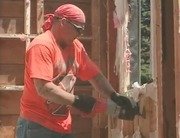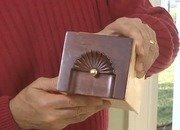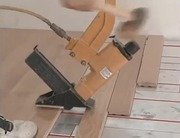Moisture Content and Vapor Barrier for Wood Floors
Howard Brickman shows Bob two ways to measure the moisture content of wood.
Clip Summary
For proper installation, wood flooring should be allowed to acclimate to its surrounding environment before it is installed. Too much or too little moisture in the flooring can cause it to bow, buckle, split, or crack after it is installed.In the dining room, flooring specialist Howard Brickman shows Bob two ways to measure the moisture content of wood. The first is a traditional moisture meter that is stuck into the floor. The second is the FloorWatch system, which can be monitored remotely. The FloorWatch system monitors moisture levels, temperature, and relative humidity. It can be accessed over the phone or via a Web site.
Before putting the floor down, Brickman applies a vapor barrier that is similar to an ice shield used in roofing. A different floor fastening system is being used in this room; rather than the nailing technique used elsewhere in the house, Brickman uses screws and wood plugs.
Bob Vila: It's been a few months since we laid down our GP tough ply sub‑flooring, and of course all the different treads of trampled on it including the plaster, so it's a pretty dirty sub‑floor. Howard Brickman: Yes, it is. We need to check the moisture content, then we need to clean the sub‑floor off. Bob: All right, and you'll clean it off with this, but how do you check the moisture? Howard: Well, we check the moisture, and the content with the sub‑floor with a portable moisture meter in most cases. We put the pins in, and the press the needle, and it gives us a reading. The other device we use, we have a monitoring system we install in the house. It has a moisture meter, a relative humidity and temperature circuit. We report the data with a telephone line to our website, and it records the data, and you can actually print it out, and monitor it. This is the print out of the current job. We started monitoring on 16th July... Bob: Oh boy. Howard: ...and it gives a continuous reading of temperature relative humidity, and moisture content in the sub‑floor. Bob: That is pretty impressive. Howard: It's very convenient for those of us who have to drive an hour, or two to get to the job. It eliminates that travel time. Bob: Now, this is going to grind down. It's really not going to break the surface, or anything, right? Howard: No, not really. It's a very coarse abrasive. It's actually fairly worn down. We've used it on concrete before, and what we're doing is we're just knocking the plaster dust, and the other stuff off of it. Mix it down. Howard: It also takes a high spots of the sub‑floor. Bob: Sure. Now, the secret ingredient is going to be an ice shield, right? Howard: Yes, it's a bitumen membrane that's primary asphalt. It's primarily used on roof applications, but we found that it's a really effective vapor barrier. We add a little... Bob: Howard, I think we'll let your son, Richard, be your helper here. Howard: Yes, sir. Bob: This is like fly paper when you take off the back craft grinder. Howard: Yes, sir. It's really tough to work with. Bob: Right to the wall. Then of course you'll be trimming... Howard: Trimming around in the openings. Bob: ...trimming thing else. But now, you'll put continuous sections of... Howard: All the way across the room. Bob: ...the shield all the way across the room before you start bringing in the wood. Now, Howard, will you use the same adhesive nailing system that we have over there? Howard: No, we can't apply adhesive because we don't have a bare wood floor it to stick to. Bob: I see. Howard: What we'll do is we'll increase our nailing pattern. We'll also mark out joist location, and then we'll put screws, and we'll put wood plugs ‑‑ matching wood plugs ‑‑ over the holes so you don't see the screw wholes. Bob: The main thing is to be assured that the finished job is not going cup, or absorb any plaster. Howard: Exactly. It's mechanical restrain...






